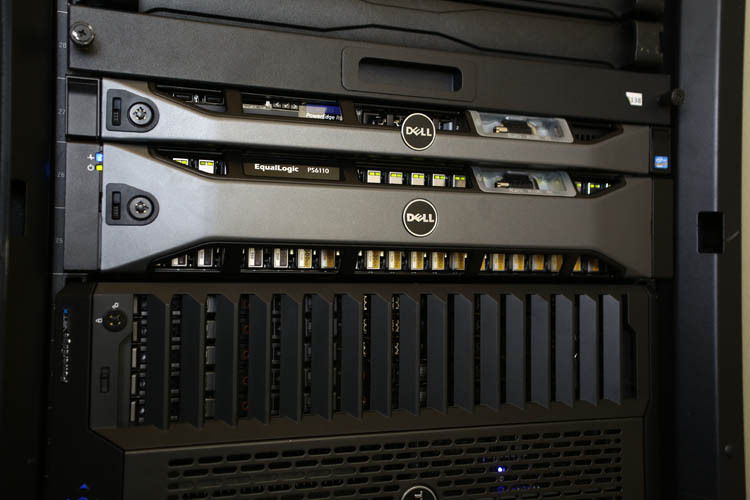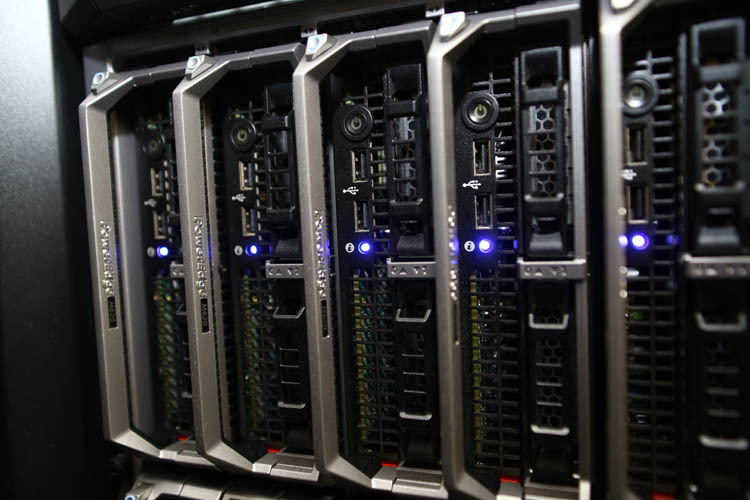How Dell hardware drives, mounts and maintains + implementation example

We have recently opened the first Dell solution center in the Russian Federation - a place where the infrastructure (software plus various hardware) from this manufacturer is deployed. But I’m going to talk not so much about him, but about how the equipment is assembled, lucky and what to do, if smoke suddenly came out of the case, and why do we need “mini-data centers under the table” in Russia.

')
In the meantime, get acquainted - the Active System stand is as follows:
- 1 Dell PowerEdge M1000e Blade Chassis - 9 Fans, 6 2,700 W PSUs;
- 2 Dell MXL 10 / 40GbE Blade Switches - external ports per switch - 2 x 40 Gb / s with no additional modules, FTOS - 9.2, 6 DAC cables;
- 6 Dell PowerEdge M620 Blade Servers - 2 E5-2660 CPUs, 128 GB RAM (8 GB, 16 GB, 1600 MHz), BRCM 10GbE 2-Port 57810, PERC S110, Dual SD Card;
- Dell PowerEdge R620 server - 1 E5-2620 processor, 96 GB of RAM (6 x 16 GB, 1333 MHz), BRCM 10G / GbE (2 + 2) -Port 57800, PERC S110, Dual SD Card;
- Dell EqualLogic PS6110XS storage system - RAID 6 Accelerated, 7x400 GB SSD, 17x600 GB 10K SAS;
- 2 Dell Force10 S4810 optical switches.
Service
Dell is not a Russian company, so the service is made by partners here. We are one of the key partners of Dell, we have been working with the vendor for 10 years and have jointly implemented about 400 projects, plus we have the largest stock of spare parts. The service works 24/7, for hardware and integrated systems (PAKi), the default is a 3-year warranty from the vendor, which can extend up to 7 years.
The service contract can be maintained with us, we also have a spare parts warehouse. There are also “greetings” from the 90s, which may really be necessary for someone.

Stock
The response time under the standard warranty is 1 business day from incident registration to system recovery. For critical services, the level of banking response time is 4 hours (in Moscow), so we have a special “flying” engineering shift for our Dell center and other vendors. It is clear that in Vladivostok or Novosibirsk, in 4 hours, nothing can be lifted, but if necessary, we will also fly there with a piece of iron on the next flight.
Installation
Iron of this level is rarely supplied in series. Each model is built for a specific customer and a specific butt.
If we are talking about VRTX (this is such a mini data center in a single package, the dimensions of which do not exceed the size of the nightstand, it is placed under the table, does not require special cooling and is plugged into a standard 220 V outlet), then it is fully assembled in Europe at one of the largest Dell production hubs.
VRTX Configuration Example:
- Dell PowerEdge VRTX blade chassis - 6 internal and 4 external fans, 4 PSU 1100 W;
- 3 Dell PowerEdge M520 Blade Servers - 2 E5-2420 processors, 32 GB of RAM (4 GB each, 1333 MHz), Broadcom Gigabit Ethernet BCM5720, PERC H310 Mini;
- 6 disks 300 GB 15K SAS;
- 6 disks of 300 GB 10K SAS;
- Blade Switch R1-2401 VRTX 1Gb;
- AMD FirePro V9800P graphics card;
- Intel 10GbE 2-Port X520 Network Card.
After assembly, it is packaged in a dense shipping container (wood and metal) and glued on all sides by stress sensors and roll sensors. This is in case, if the transport company suddenly drops the server, comparable to the cost of a large truck (or even more than one), it will be clear that it was she who did it.
The rack cannot be shaken, it cannot be tilted more than 30 degrees (usually), it cannot be dropped, it cannot be wetted. Plus, the transportation of such things is useful to keep track of the map if the body of the truck breaks through with a cellular signal. If the rack is tilted or shaken, the disks may fail, something can fly in vertically mounted or horizontally mounted boards. Given the nature of the loads (constant and high, that is, in the critical mode for conventional equipment), the rack will then fail. That is why, on any of the sensors, an expensive guarantee immediately flies.
Problems, as a rule, begin during installation, when it turns out that this heavy rack needs to be brought into the office upstairs and hauled through the entire carpet floor.
The Active System stand is one or several racks, which are also assembled for the customer, but from the modules on our side. We get network equipment and software to the warehouse, mount it in a rack, test it, hang it with sensors and carry it collected according to the previous scenario. The customer receives it already assembled, configured for specific tasks, for example, for VDI tasks, access control or performance diagnostics.

Router stands in the test area. Visible free space.
Calculations
Both systems are used for serious corporate tasks. VRTX is usually for the fastest and easiest deployment of several services such as Exchange for several hundred users, or for calculating 3D graphics for an animation studio, as well as other tasks of this class. I bought it, put it in, turned it on, turned on the network, picked it up for 3-4 days and forgot it. It is working, and we are watching everything.
The mini data center weighs no more than 70 kg. This is the maximum to which you can score. Empty basket weight is about 25 kg.
The Active System is used for high-load applications, regardless of the company's business, be it financial, oil, medical or other. Plus, such a system is useful for virtualization of retail and jobs in large companies. In general, a piece of your data center or data center entirely.
Physically, this is also a fairly light rack - at 213 kilograms (following the configuration example above, Compellent - 19.73 kg + R620 25 kg + blade servers + basket 80 kg + 6 * 7 kg + Storage EqualLogic PS6110XS - 26 kg + shelf to Compellent about 20 kg). That is, three or four men can easily lift.
It emits heat - 2765 W / hour.
Maximum power consumption - 2766 watts.
An example of using Active System
The customer turned to us for a solution to the problem of simplifying the administration of workplaces for 1000 employees and enhancing information security. Most likely, the customer needed to optimize IT costs and transfer capital costs to operating costs, since he understood that some chaos reigns in the current infrastructure and it is time to grow to the next level.
The main functionality is the allocation of physical machines to users, asset management, hardware and software configuration management, installation of operating systems and applications. As a result of the audit, a solution was proposed to build a virtual infrastructure (VDI) on Dell hardware.
Under the VDI script, the desktop operating system and applications run on virtual machines hosted on the server, and users are given remote access to these machines. The components of VDI are: storage system, server and network equipment, hypervisor, connection broker and thin client.
The following Dell hardware is used as computing power:
- 16 Dell PowerEdge M620 Blade Servers (2 x Intel Xeon E5-2670v2 \ 192Gb Memory) - main power resources;
- 2 Dell PowerEdge R620 (Intel Xeon E5-2630v2) servers required to manage computing power;
- external disk storage with a total capacity of up to 51.6 TB; Dell Compilent SC8000 storage system.
Software such:
- vWorkspace connection broker;
- VMware hypervisor (or Microsoft Hyper-V);
- Active System Manager.
Users can use thin clients to access their virtual PCs. This project uses the Dell Wyse D10D. As you have already noticed, to build the infrastructure we use all the equipment and software from one vendor. This is a definite plus, since the system is supported by one manufacturer and is a complete solution for which the contractor is responsible. Completely. It was necessary for the introductory "some chaos." The fact is that Dell, perhaps, is the only vendor who can offer such a complete portfolio for such tasks. Both software and hardware are delivered and serviced within the framework of one company, and if a problem arises somewhere, they will solve it, rather than looking for the guilty in another division.
Thus, using VDI, the customer gets the continuity of the business process (jobs are available at any time and from any place), reducing the cost of acquiring and maintaining physical PCs, increasing the level of information security. A 4-hour SLA is ordered, which greatly pleases the customer’s employees who control risks. Also in the pros - simplified infrastructure and load management system (no unnecessary idle capacity), providing flexibility and scalability with an eye to the future, flexibility in the choice of configurations (iron set is compiled in each case), the implementation of the customer in a short time. The system is configured on the side of the executive integrator, that is, the entry point for service support is unified (CROC + Dell).
The cost of one workplace is about 4-5 thousand dollars, depending on the configuration (this is an estimated cost of the conditional price list, from which serious discounts are possible). In size, the system fits in a 42U rack.
Solution Center
We also have VRTX for medium-sized businesses, and more expensive (about an order of magnitude more expensive) AS for large businesses. You can watch them, test their application services on them (including their own program, if there is such a need), evaluate the work on the simulator under load. If interested - write to nsofronova@croc.ru , I will tell you more about the Dell Solution Center.
Source: https://habr.com/ru/post/237757/
All Articles